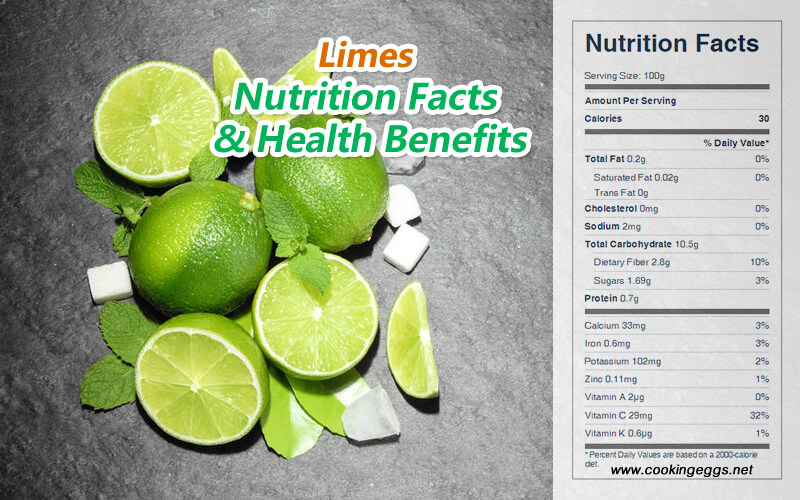Lime Nutrition Facts and Health Benefits
Lime is a small citrus fruit, whose skin and flesh are green in color, and which has an oval or round shape and contains acidic juice vesicles.
Nutritional Value of Lime
Raw limes are 88% water, 10% carbohydrates, and less than 1% each of fat and protein. Only vitamin C content at 35% of the Daily Value per 100 g serving is significant for nutrition, with other nutrients present in low DV amounts. Lime juice contains slightly less citric acid than lemon juice, nearly twice the citric acid of grapefruit juice, and about five times the amount of citric acid found in orange juice.
One medium raw lime provides 20 calories, 7.1 g carbohydrate, 0.5 g protein, 0.1 g fat, 1.9 g dietary fiber, 7 IU vitamin A, 19 mg vitamin C, 5 mcg folic acid, 0.15 mg pantothenic acid, 68 mg potassium, 1 mg sodium, 22 mg calcium, 12 mg phosphorus, 4 mg magnesium, and 0.4 mg iron.

Raw Limes Nutrition Facts Label
Health Benefits of Limes
Lime contains unique flavonoid compounds that have antioxidant and anti-cancer properties. Of special interest in limes have been flavonoids called flavonol glycosides, including many kaempferol-related molecules. While these flavonoids have been shown to stop cell division in many cancer cell lines, they are perhaps most interesting for their antibiotic effects.
Several other fascinating research studies on the healing properties of limes have shown that cell cycles, including the decision a cell makes about whether to divide (called mitosis) or die (apoptosis), are altered by lime juice, as are the activities of special immune cells called monocytes.
In addition to their unique phytonutrient properties, limes are an excellent source of one of the most important antioxidants in nature, vitamin C. Vitamin C is one of the main antioxidants found in food and the primary water-soluble antioxidant in the body. As Vitamin C travels through the body, neutralizing any free radicals with which it comes into contact in the aqueous environments in the body, both inside and outside cells, Free radicals can interact with the healthy cells of the body, damaging them and their membranes and also causing a lot of inflammation, or painful swelling, in the body. This is one of the reasons that vitamin C has been shown to be helpful for reducing some of the symptoms of osteoarthritis and rheumatoid arthritis.
Since free radicals can damage blood vessels and can change cholesterol to make it more likely to build up in artery walls, vitamin C can be helpful in preventing the development and progression of atherosclerosis and diabetic heart disease.
Vitamin C is also vital to the function of a strong immune system. The immune system’s main goal is to protect you from illness, so a little extra vitamin C may be useful in conditions like colds, flu’s, and recurrent ear infections.
Although not as dense in the following nutrients as they are with vitamin C, lemons and limes also provide small amounts of vitamin B6, potassium and folate. Usually smaller than lemons, limes are oval or round ins shape having a diameter of one to two inches with green flesh and skin. They can be either sour or sweet depending on the variety. Sour limes contain citric acid giving them an acidic and tart taste, while sweet limes while lack citric acid and are sweeter in flavor.